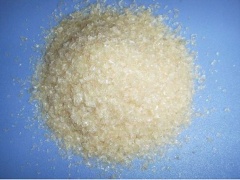Gelatin
| Infobox on Gelatin | |
|---|---|
| Example of Gelatin |  |
| Facts | |
| Origin | - |
| Stowage factor (in m3/t) | 3,40/5,94 m3/t |
| Humidity / moisture | - |
| Ventilation | - |
| Risk factors | See text |
Gelatin
Description / Application
Gelatin is a mixture of proteins obtained by hydrolysis of collagen by boiling skin, ligaments, tendons, etc. Its production differs from that of animal glue in that the raw materials are selected, cleaned, and treated with special care so that the product is cleaner and purer than glue. Type A gelatin is obtained from acid-treated raw materials, and Type B from alkali-treated raw materials. Gelatin is strongly hydrophilic, absorbing up to 10 times its weight of water and forming reversible gels of high strength and viscosity.
Gelatin melts to a liquid when heated and solidifies when cooled again. Together with water, it forms a semi-solid colloid gel. Gelatin forms a solution of high viscosity in water, which sets to a gel on cooling, and its chemical composition is, in many respects, closely similar to that of its parent collagen. Gelatin is also soluble in most polar solvents.
Gelatin solutions show viscoelastic flow and streaming birefringence. If gelatin is put into contact with cold water, some of the material dissolves, but not all. The solubility of the gelatin is determined by the method of manufacture. Typically, gelatin can be dispersed in a relatively concentrated acid. Such dispersions are stable for 10–15 days with little or no chemical changes and are suitable for coating purposes or for extrusion into a precipitating bath.
Gelatin gels exist over only a small temperature range, the upper limit being the melting point of the gel, which depends on gelatin grade and concentration (but is typically less than 35 °C) and the lower limit the freezing point at which ice crystallizes. The upper melting point is below human body temperature, a factor which is important for mouthfeel of foods produced with gelatin.
Use: photographic film, sizing, textile and paper adhesives, cements, capsules for medicinals, matches, light filters, clarifying agent, desserts, jellies, etc., culture medium for bacteria, blood plasma volume expander, microencapsulation, printing inks, nutrient, protective colloid in ice cream.
Food grade gelatin is produced mainly from two raw materials, beef skin and pork hide.
Photographic and pharma grades of gelatin are generally made from beef bones, although some beef bone gelatin is used by the food industry. Gelatin is an animal protein unlike many other gelling agents used by the food industry.
Shipment / Storage / Risk factors
Shipped in powder or sheet form in drums, bags or cans inside cases. Sheet and powdered gelatin should be stored at a moderate temperature, i.e. not near a boiler-room or engine-room and not exposed to the direct heat of the sun. When packed in bags, it may lose weight under dry conditions.
Exposure to moist air or contact with water will cause mould attack and lumpiness which would completely spoil edible and photographic gelatine for those purposes and leave a material of greatly reduced value as a source of glue. Powdered gelatine becomes hard and horny when wetted but can also be utilized for glue manufacture.
If prepared as a food product, it is readily contaminated when exposed.
Properties: flakes or powder, odourless, tasteless, soluble in warm water and glycerol; insoluble in organic solvents.











